Financial Analysis Report: S&P Plc Business Decision Making Projects
VerifiedAdded on 2023/06/07
|7
|1269
|450
Report
AI Summary
This report provides a comprehensive financial analysis of two potential projects for S&P Plc, a bag manufacturing company. The analysis focuses on evaluating the projects using Net Present Value (NPV), payback period, and other relevant financial and non-financial factors to determine the most profitable investment. The report calculates the net cash flows for each project, considering an 11% discounting rate, and compares the outcomes. Project A, involving synthetic leather bags, and Project B, dealing with clothes bags, are assessed based on their respective investment amounts and cash inflows over a five-year period. The analysis concludes that Project A is the superior choice for S&P Plc due to its higher net cash inflow. Furthermore, the report explains the methodologies of payback period, NPV, financial methods (financial statements, ratio analysis), and non-financial methods (meeting legislation, industry standards, customer relationships, and goodwill) used in the decision-making process. The report emphasizes that business decision-making relies on multiple variables to identify the most profitable option. The references include books and journals that support the analysis.

Business Decision
Making
Making
Paraphrase This Document
Need a fresh take? Get an instant paraphrase of this document with our AI Paraphraser

Contents
Contents...........................................................................................................................................2
INTRODUCTION...........................................................................................................................1
MAIN BODY..................................................................................................................................1
CONCLUSION................................................................................................................................4
REFERENCES................................................................................................................................5
Contents...........................................................................................................................................2
INTRODUCTION...........................................................................................................................1
MAIN BODY..................................................................................................................................1
CONCLUSION................................................................................................................................4
REFERENCES................................................................................................................................5
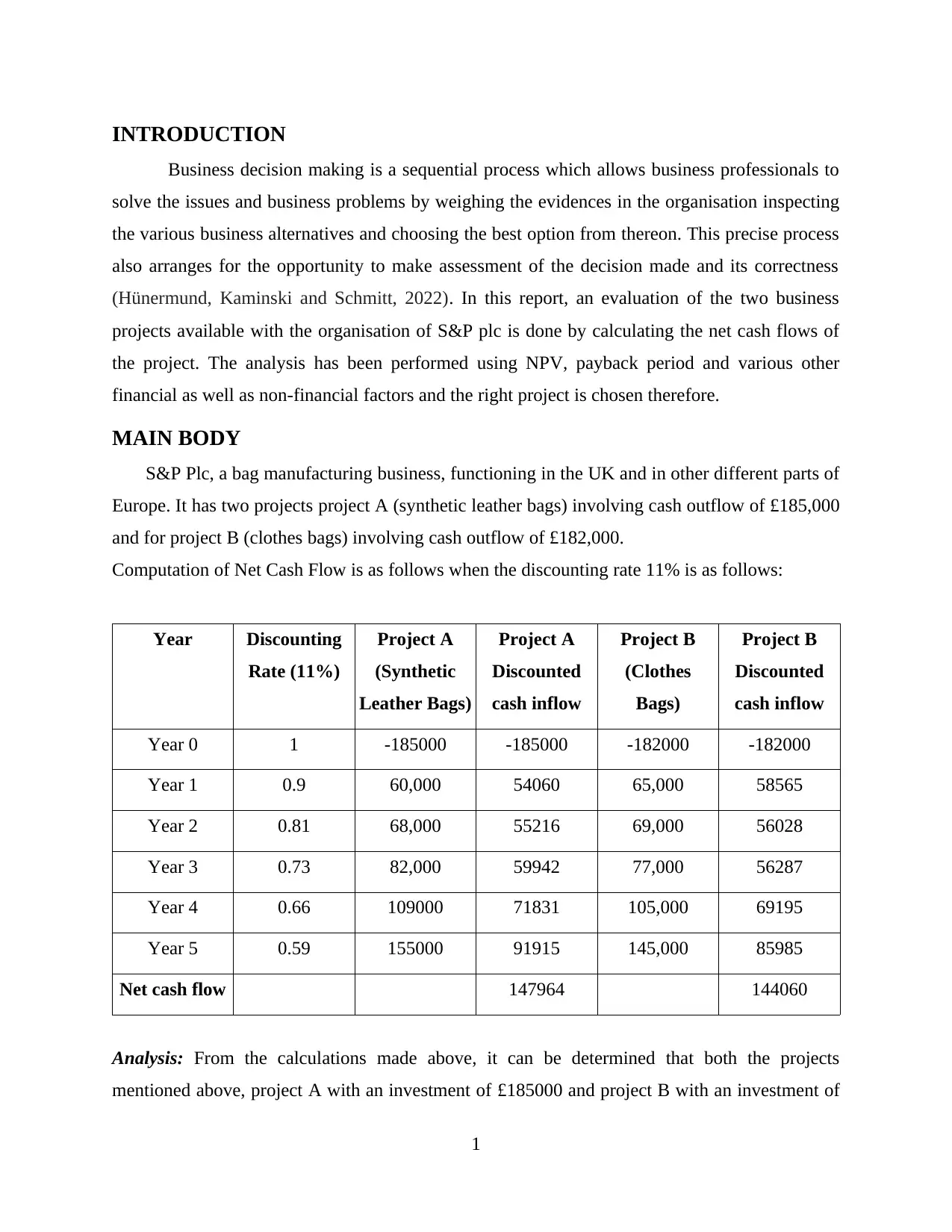
INTRODUCTION
Business decision making is a sequential process which allows business professionals to
solve the issues and business problems by weighing the evidences in the organisation inspecting
the various business alternatives and choosing the best option from thereon. This precise process
also arranges for the opportunity to make assessment of the decision made and its correctness
(Hünermund, Kaminski and Schmitt, 2022). In this report, an evaluation of the two business
projects available with the organisation of S&P plc is done by calculating the net cash flows of
the project. The analysis has been performed using NPV, payback period and various other
financial as well as non-financial factors and the right project is chosen therefore.
MAIN BODY
S&P Plc, a bag manufacturing business, functioning in the UK and in other different parts of
Europe. It has two projects project A (synthetic leather bags) involving cash outflow of £185,000
and for project B (clothes bags) involving cash outflow of £182,000.
Computation of Net Cash Flow is as follows when the discounting rate 11% is as follows:
Year Discounting
Rate (11%)
Project A
(Synthetic
Leather Bags)
Project A
Discounted
cash inflow
Project B
(Clothes
Bags)
Project B
Discounted
cash inflow
Year 0 1 -185000 -185000 -182000 -182000
Year 1 0.9 60,000 54060 65,000 58565
Year 2 0.81 68,000 55216 69,000 56028
Year 3 0.73 82,000 59942 77,000 56287
Year 4 0.66 109000 71831 105,000 69195
Year 5 0.59 155000 91915 145,000 85985
Net cash flow 147964 144060
Analysis: From the calculations made above, it can be determined that both the projects
mentioned above, project A with an investment of £185000 and project B with an investment of
1
Business decision making is a sequential process which allows business professionals to
solve the issues and business problems by weighing the evidences in the organisation inspecting
the various business alternatives and choosing the best option from thereon. This precise process
also arranges for the opportunity to make assessment of the decision made and its correctness
(Hünermund, Kaminski and Schmitt, 2022). In this report, an evaluation of the two business
projects available with the organisation of S&P plc is done by calculating the net cash flows of
the project. The analysis has been performed using NPV, payback period and various other
financial as well as non-financial factors and the right project is chosen therefore.
MAIN BODY
S&P Plc, a bag manufacturing business, functioning in the UK and in other different parts of
Europe. It has two projects project A (synthetic leather bags) involving cash outflow of £185,000
and for project B (clothes bags) involving cash outflow of £182,000.
Computation of Net Cash Flow is as follows when the discounting rate 11% is as follows:
Year Discounting
Rate (11%)
Project A
(Synthetic
Leather Bags)
Project A
Discounted
cash inflow
Project B
(Clothes
Bags)
Project B
Discounted
cash inflow
Year 0 1 -185000 -185000 -182000 -182000
Year 1 0.9 60,000 54060 65,000 58565
Year 2 0.81 68,000 55216 69,000 56028
Year 3 0.73 82,000 59942 77,000 56287
Year 4 0.66 109000 71831 105,000 69195
Year 5 0.59 155000 91915 145,000 85985
Net cash flow 147964 144060
Analysis: From the calculations made above, it can be determined that both the projects
mentioned above, project A with an investment of £185000 and project B with an investment of
1
⊘ This is a preview!⊘
Do you want full access?
Subscribe today to unlock all pages.

Trusted by 1+ million students worldwide
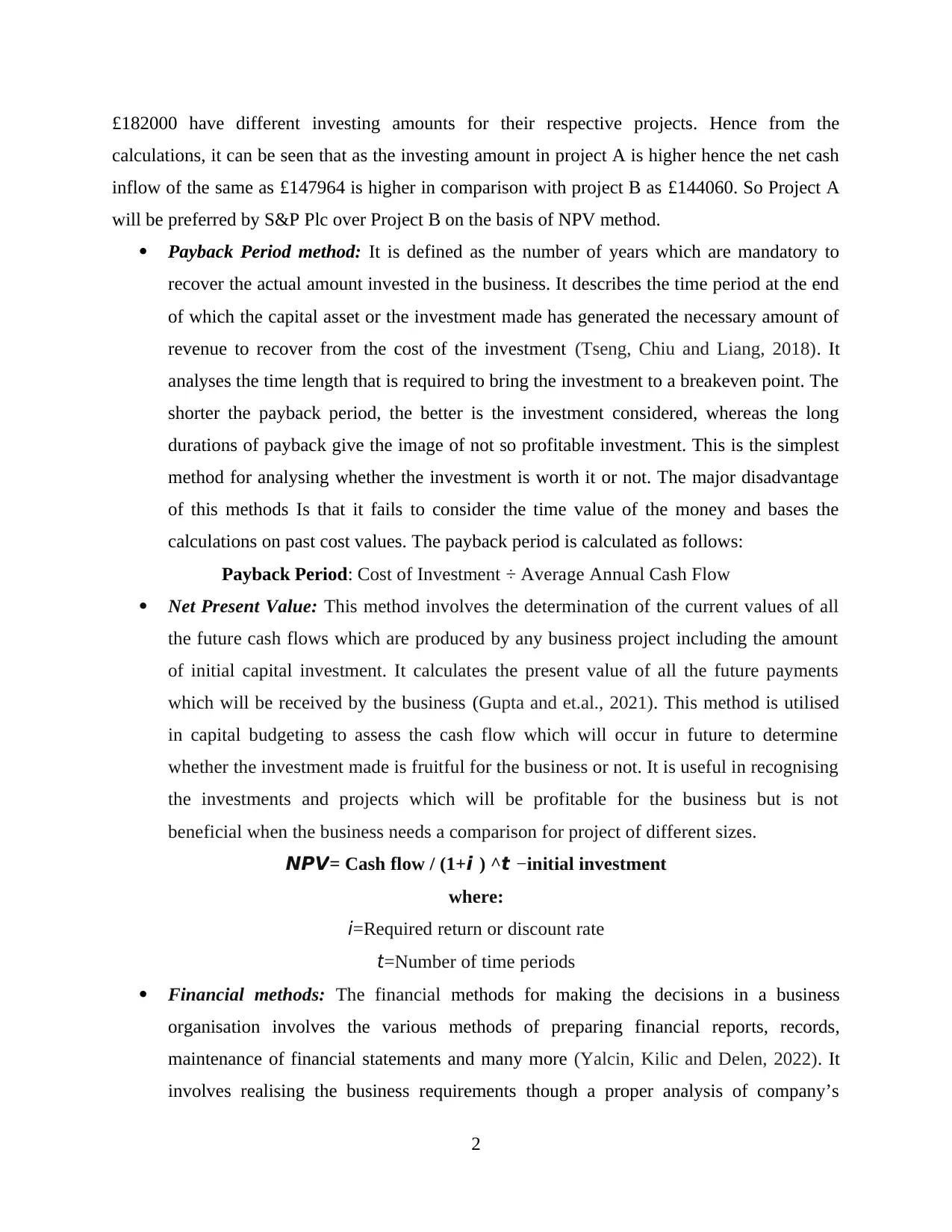
£182000 have different investing amounts for their respective projects. Hence from the
calculations, it can be seen that as the investing amount in project A is higher hence the net cash
inflow of the same as £147964 is higher in comparison with project B as £144060. So Project A
will be preferred by S&P Plc over Project B on the basis of NPV method.
Payback Period method: It is defined as the number of years which are mandatory to
recover the actual amount invested in the business. It describes the time period at the end
of which the capital asset or the investment made has generated the necessary amount of
revenue to recover from the cost of the investment (Tseng, Chiu and Liang, 2018). It
analyses the time length that is required to bring the investment to a breakeven point. The
shorter the payback period, the better is the investment considered, whereas the long
durations of payback give the image of not so profitable investment. This is the simplest
method for analysing whether the investment is worth it or not. The major disadvantage
of this methods Is that it fails to consider the time value of the money and bases the
calculations on past cost values. The payback period is calculated as follows:
Payback Period: Cost of Investment ÷ Average Annual Cash Flow
Net Present Value: This method involves the determination of the current values of all
the future cash flows which are produced by any business project including the amount
of initial capital investment. It calculates the present value of all the future payments
which will be received by the business (Gupta and et.al., 2021). This method is utilised
in capital budgeting to assess the cash flow which will occur in future to determine
whether the investment made is fruitful for the business or not. It is useful in recognising
the investments and projects which will be profitable for the business but is not
beneficial when the business needs a comparison for project of different sizes.
NPV= Cash flow / (1+i ) ^t −initial investment
where:
i=Required return or discount rate
t=Number of time periods
Financial methods: The financial methods for making the decisions in a business
organisation involves the various methods of preparing financial reports, records,
maintenance of financial statements and many more (Yalcin, Kilic and Delen, 2022). It
involves realising the business requirements though a proper analysis of company’s
2
calculations, it can be seen that as the investing amount in project A is higher hence the net cash
inflow of the same as £147964 is higher in comparison with project B as £144060. So Project A
will be preferred by S&P Plc over Project B on the basis of NPV method.
Payback Period method: It is defined as the number of years which are mandatory to
recover the actual amount invested in the business. It describes the time period at the end
of which the capital asset or the investment made has generated the necessary amount of
revenue to recover from the cost of the investment (Tseng, Chiu and Liang, 2018). It
analyses the time length that is required to bring the investment to a breakeven point. The
shorter the payback period, the better is the investment considered, whereas the long
durations of payback give the image of not so profitable investment. This is the simplest
method for analysing whether the investment is worth it or not. The major disadvantage
of this methods Is that it fails to consider the time value of the money and bases the
calculations on past cost values. The payback period is calculated as follows:
Payback Period: Cost of Investment ÷ Average Annual Cash Flow
Net Present Value: This method involves the determination of the current values of all
the future cash flows which are produced by any business project including the amount
of initial capital investment. It calculates the present value of all the future payments
which will be received by the business (Gupta and et.al., 2021). This method is utilised
in capital budgeting to assess the cash flow which will occur in future to determine
whether the investment made is fruitful for the business or not. It is useful in recognising
the investments and projects which will be profitable for the business but is not
beneficial when the business needs a comparison for project of different sizes.
NPV= Cash flow / (1+i ) ^t −initial investment
where:
i=Required return or discount rate
t=Number of time periods
Financial methods: The financial methods for making the decisions in a business
organisation involves the various methods of preparing financial reports, records,
maintenance of financial statements and many more (Yalcin, Kilic and Delen, 2022). It
involves realising the business requirements though a proper analysis of company’s
2
Paraphrase This Document
Need a fresh take? Get an instant paraphrase of this document with our AI Paraphraser
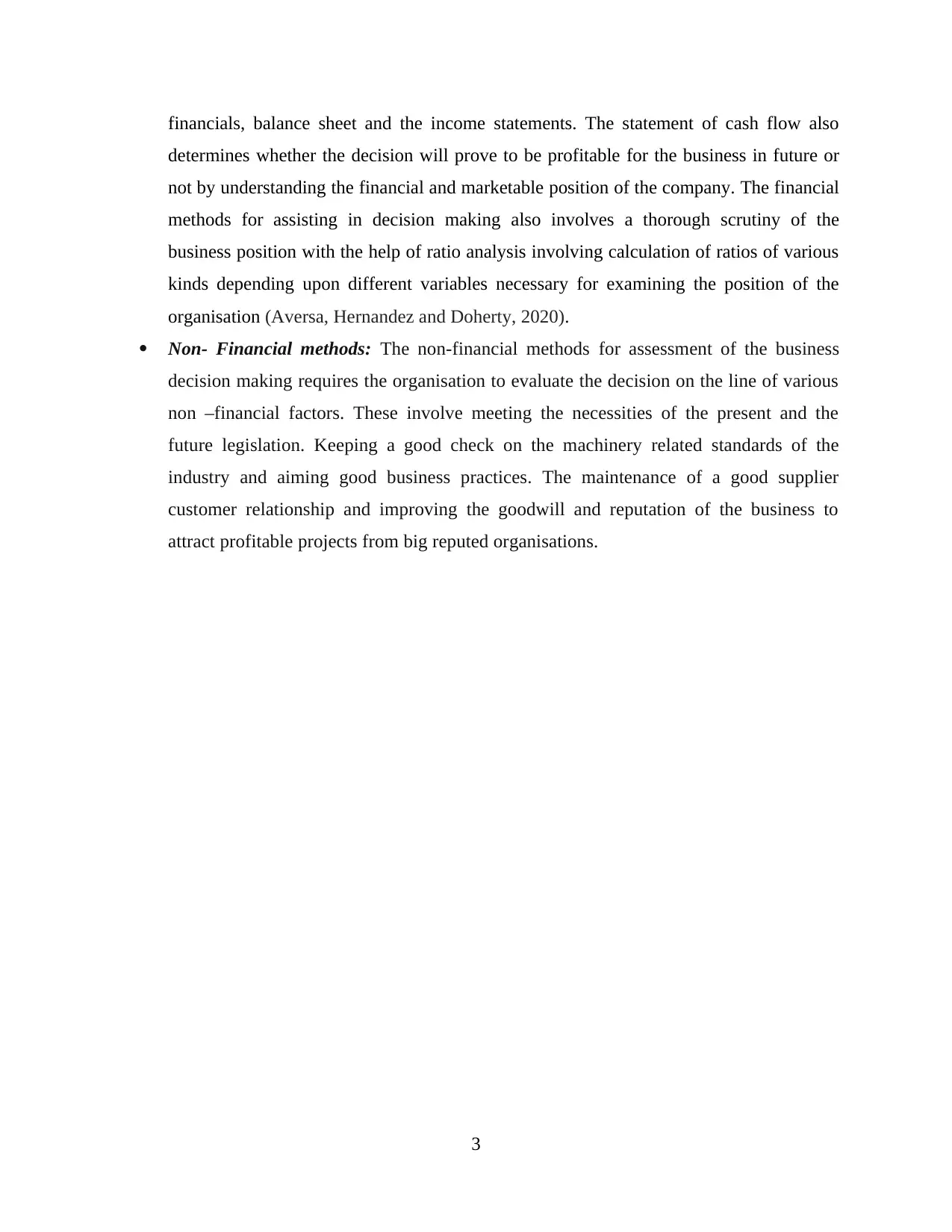
financials, balance sheet and the income statements. The statement of cash flow also
determines whether the decision will prove to be profitable for the business in future or
not by understanding the financial and marketable position of the company. The financial
methods for assisting in decision making also involves a thorough scrutiny of the
business position with the help of ratio analysis involving calculation of ratios of various
kinds depending upon different variables necessary for examining the position of the
organisation (Aversa, Hernandez and Doherty, 2020).
Non- Financial methods: The non-financial methods for assessment of the business
decision making requires the organisation to evaluate the decision on the line of various
non –financial factors. These involve meeting the necessities of the present and the
future legislation. Keeping a good check on the machinery related standards of the
industry and aiming good business practices. The maintenance of a good supplier
customer relationship and improving the goodwill and reputation of the business to
attract profitable projects from big reputed organisations.
3
determines whether the decision will prove to be profitable for the business in future or
not by understanding the financial and marketable position of the company. The financial
methods for assisting in decision making also involves a thorough scrutiny of the
business position with the help of ratio analysis involving calculation of ratios of various
kinds depending upon different variables necessary for examining the position of the
organisation (Aversa, Hernandez and Doherty, 2020).
Non- Financial methods: The non-financial methods for assessment of the business
decision making requires the organisation to evaluate the decision on the line of various
non –financial factors. These involve meeting the necessities of the present and the
future legislation. Keeping a good check on the machinery related standards of the
industry and aiming good business practices. The maintenance of a good supplier
customer relationship and improving the goodwill and reputation of the business to
attract profitable projects from big reputed organisations.
3
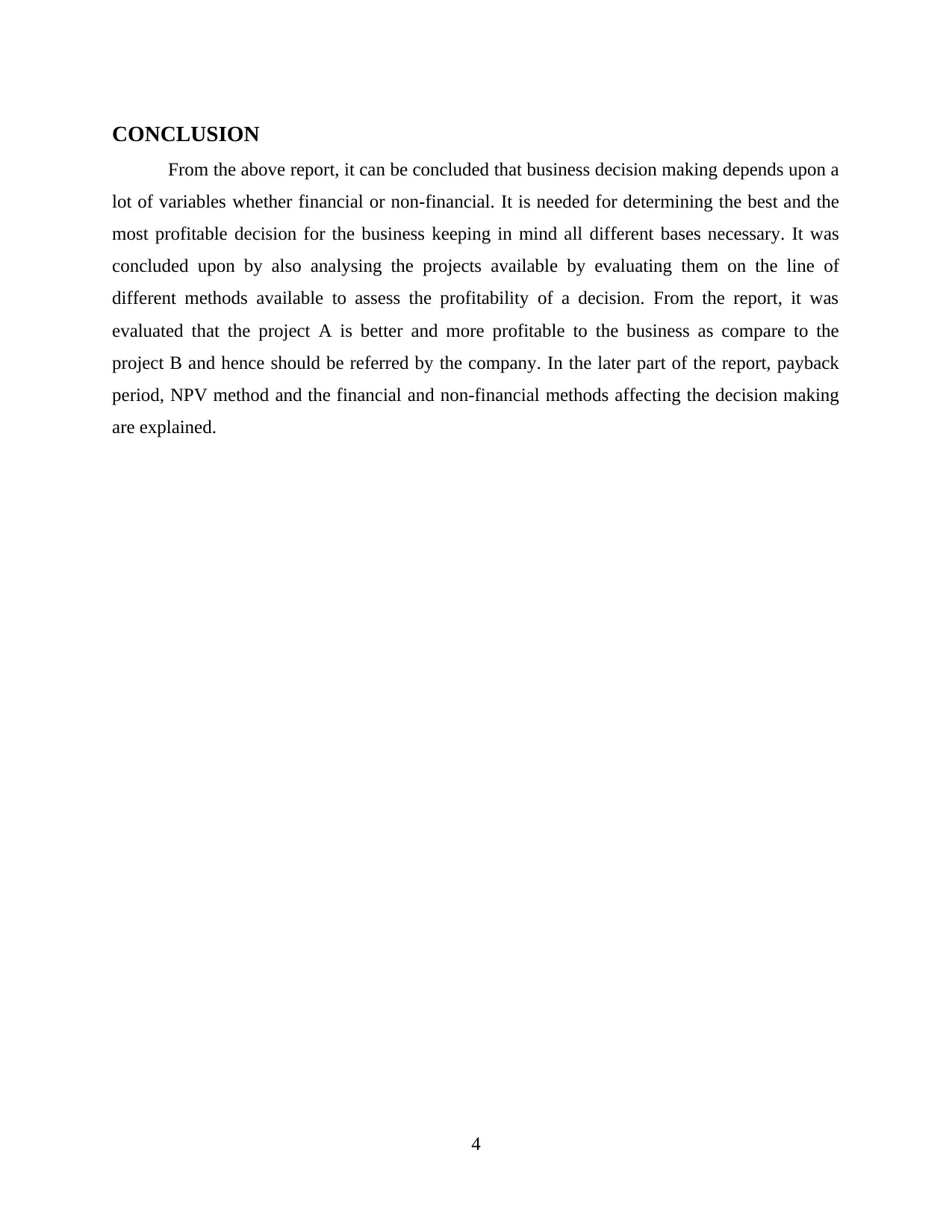
CONCLUSION
From the above report, it can be concluded that business decision making depends upon a
lot of variables whether financial or non-financial. It is needed for determining the best and the
most profitable decision for the business keeping in mind all different bases necessary. It was
concluded upon by also analysing the projects available by evaluating them on the line of
different methods available to assess the profitability of a decision. From the report, it was
evaluated that the project A is better and more profitable to the business as compare to the
project B and hence should be referred by the company. In the later part of the report, payback
period, NPV method and the financial and non-financial methods affecting the decision making
are explained.
4
From the above report, it can be concluded that business decision making depends upon a
lot of variables whether financial or non-financial. It is needed for determining the best and the
most profitable decision for the business keeping in mind all different bases necessary. It was
concluded upon by also analysing the projects available by evaluating them on the line of
different methods available to assess the profitability of a decision. From the report, it was
evaluated that the project A is better and more profitable to the business as compare to the
project B and hence should be referred by the company. In the later part of the report, payback
period, NPV method and the financial and non-financial methods affecting the decision making
are explained.
4
⊘ This is a preview!⊘
Do you want full access?
Subscribe today to unlock all pages.

Trusted by 1+ million students worldwide
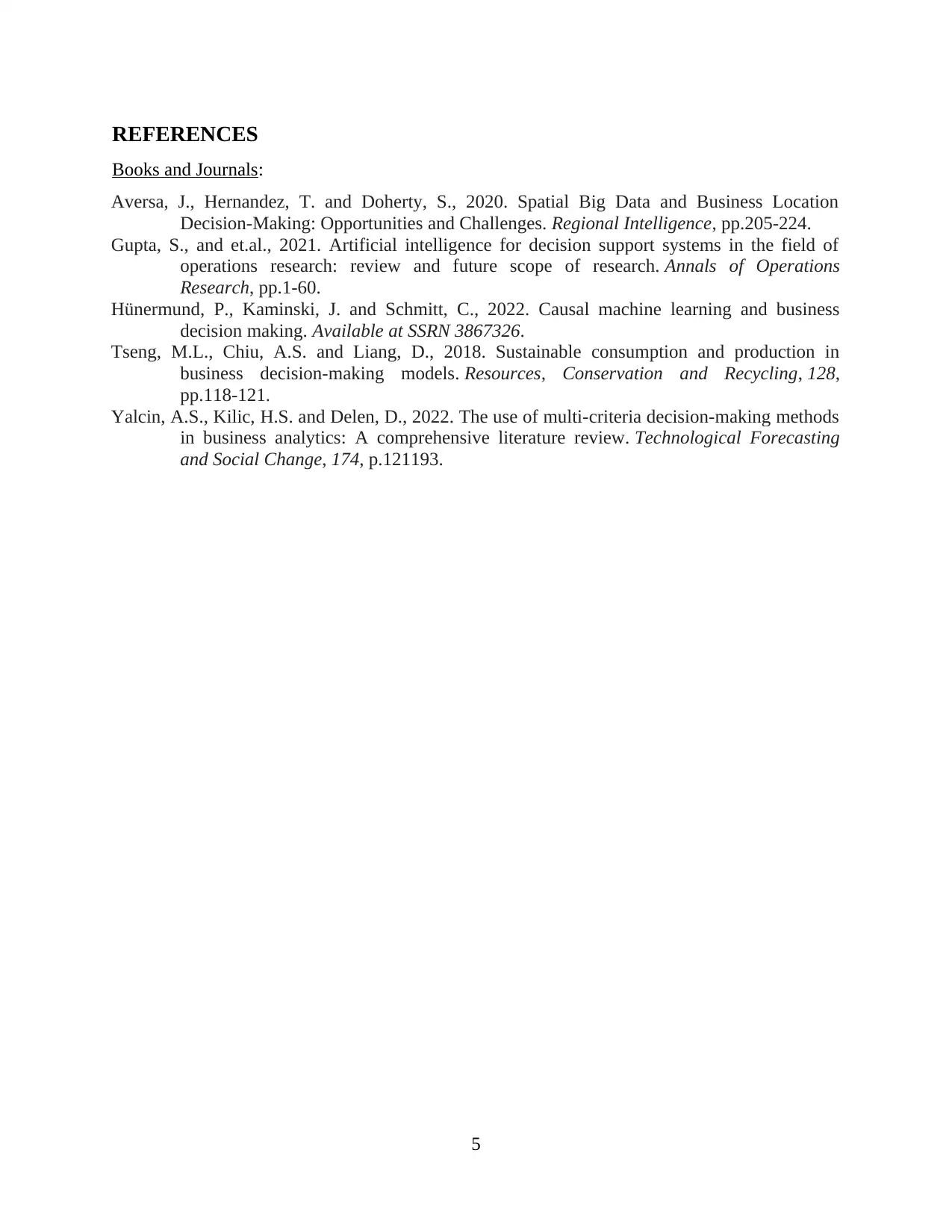
REFERENCES
Books and Journals:
Aversa, J., Hernandez, T. and Doherty, S., 2020. Spatial Big Data and Business Location
Decision-Making: Opportunities and Challenges. Regional Intelligence, pp.205-224.
Gupta, S., and et.al., 2021. Artificial intelligence for decision support systems in the field of
operations research: review and future scope of research. Annals of Operations
Research, pp.1-60.
Hünermund, P., Kaminski, J. and Schmitt, C., 2022. Causal machine learning and business
decision making. Available at SSRN 3867326.
Tseng, M.L., Chiu, A.S. and Liang, D., 2018. Sustainable consumption and production in
business decision-making models. Resources, Conservation and Recycling, 128,
pp.118-121.
Yalcin, A.S., Kilic, H.S. and Delen, D., 2022. The use of multi-criteria decision-making methods
in business analytics: A comprehensive literature review. Technological Forecasting
and Social Change, 174, p.121193.
5
Books and Journals:
Aversa, J., Hernandez, T. and Doherty, S., 2020. Spatial Big Data and Business Location
Decision-Making: Opportunities and Challenges. Regional Intelligence, pp.205-224.
Gupta, S., and et.al., 2021. Artificial intelligence for decision support systems in the field of
operations research: review and future scope of research. Annals of Operations
Research, pp.1-60.
Hünermund, P., Kaminski, J. and Schmitt, C., 2022. Causal machine learning and business
decision making. Available at SSRN 3867326.
Tseng, M.L., Chiu, A.S. and Liang, D., 2018. Sustainable consumption and production in
business decision-making models. Resources, Conservation and Recycling, 128,
pp.118-121.
Yalcin, A.S., Kilic, H.S. and Delen, D., 2022. The use of multi-criteria decision-making methods
in business analytics: A comprehensive literature review. Technological Forecasting
and Social Change, 174, p.121193.
5
1 out of 7
Related Documents
Your All-in-One AI-Powered Toolkit for Academic Success.
+13062052269
info@desklib.com
Available 24*7 on WhatsApp / Email
![[object Object]](/_next/static/media/star-bottom.7253800d.svg)
Unlock your academic potential
Copyright © 2020–2025 A2Z Services. All Rights Reserved. Developed and managed by ZUCOL.

